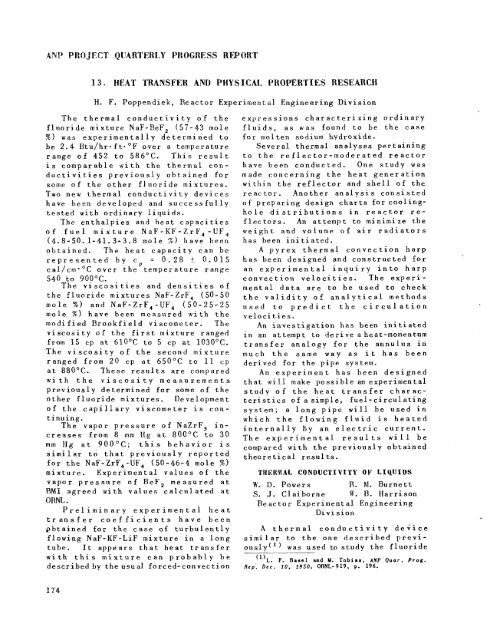the Molten Salt Energy Technologies Web Site
the Molten Salt Energy Technologies Web Site
the Molten Salt Energy Technologies Web Site
You also want an ePaper? Increase the reach of your titles
YUMPU automatically turns print PDFs into web optimized ePapers that Google loves.
ANP PROJECT QUARTERLY PIJQGRESS REPORT<br />
13. HEAT TRANSFER AND PHYSICAL PROPERTIES RESEARCH<br />
H. F. Poppendiek, Reactor ExperimenLal Engineering Division<br />
'The <strong>the</strong>rmal conductivity of <strong>the</strong><br />
fluoride mixture NaF-BeF2 (57-43 mole<br />
%) was experimentally determined to<br />
be 2.4 Btu/hr*ft."F over a temperaturr<br />
range of 452 to 586°C. This result<br />
is comparable with <strong>the</strong> <strong>the</strong>rmal con-<br />
ductivi ties previously obtained for<br />
some of <strong>the</strong> o<strong>the</strong>r fluoride mixtures.<br />
Two new <strong>the</strong>rmal conductivity devices<br />
have been developed and successfully<br />
tested with ordinary liquids.<br />
The enthalpies and heat capacities<br />
of fuel mixture NaF-KF-ZrF,-UF,<br />
(4.8-50.1-41.3-3.8 mole %) have been<br />
obtained. The heat capacity can be<br />
represented by c = 0.28 +_ 0.015<br />
P<br />
cal/cm."C over <strong>the</strong> temperature range<br />
540 to 900°C.<br />
The viscosities and densities of<br />
<strong>the</strong> fluoride mixtures NaF-ZrF, (50-50<br />
mole 760) and NaF-ZrF,-UF, (50-25-25<br />
mole 7%) have been measured with <strong>the</strong><br />
modified Brookfield viscometer. The<br />
viscosity of <strong>the</strong> first mixture ranged<br />
from 15 cp at 610°C to 5 cp at 1030°C.<br />
The viscosity of <strong>the</strong> second mixture<br />
ranged from 20 cp at 650°C to 11 cp<br />
at 880°C. These results are compared<br />
w i t X <strong>the</strong> viscosity measurements<br />
previously determined for some of <strong>the</strong><br />
0 <strong>the</strong>r fluoride mix tures. Development<br />
of <strong>the</strong> capillary viscometer is conti<br />
nuing.<br />
The vapor pressure of NaZrF, increases<br />
from 8 mm Hg at 800°C to 30<br />
mm Hg at 900°C; this behavior is<br />
similar to that previously reported<br />
for <strong>the</strong> NaF-ZrF,-UF, (50-46-4 mole X)<br />
mixture. Experimental values of <strong>the</strong><br />
vapor pressure of BeF2 measured at<br />
RMI agreed with values calculated at<br />
ORNL .<br />
Preliminary experiment a1 heat<br />
transfer coefficients have been<br />
pbtained for <strong>the</strong> case of turbulently<br />
flowing NaF-KF-LiF mixture in a long<br />
tube. It appears that heat transfer<br />
with this mixture can probably be<br />
described by <strong>the</strong> usual forced-convection<br />
174<br />
expressions characterizing ordinary<br />
fluids, as was found to be <strong>the</strong> case<br />
for mol ten sodium hydroxide.<br />
Sever a1 <strong>the</strong>rmal analyses pertaining<br />
to <strong>the</strong> reflector-moderated reactor<br />
have been conducted. One study was<br />
made concerning <strong>the</strong> heat generation<br />
within <strong>the</strong> reflector and shell of <strong>the</strong><br />
reactor. Ano<strong>the</strong>r analysis consisted<br />
of preparing design charts for cooling-<br />
hole distributions in reactor re-<br />
flectors. An attempt to minimize <strong>the</strong><br />
weight and volume of air radiators<br />
has been initiated.<br />
A pyrex <strong>the</strong>rmal convection harp<br />
has been designed and constructed for<br />
an experimental inquiry into harp<br />
convection velocities. The experi-<br />
mental dat,a are to be used to check<br />
<strong>the</strong> validity of analytical methods<br />
used to predict <strong>the</strong> circulation<br />
velocities.<br />
An investigation has been initiated<br />
in an attempt to derive a heat-momentum<br />
transfer analogy for <strong>the</strong> annulus in<br />
much <strong>the</strong> same way as it has been<br />
derived for <strong>the</strong> pipe system.<br />
An experiment has been designed<br />
that w i l l make possible an experimental<br />
study of <strong>the</strong> heat transfer chasac-<br />
teristics of a simple, fuel-circulating<br />
system; a long pipe w i l l be used in<br />
which <strong>the</strong> flowing fluid is heated<br />
internally by an electric current.<br />
The experimental results w i l l be<br />
compared with <strong>the</strong> previously obtained<br />
<strong>the</strong>oretical results.<br />
THERMAL CONDUCTIVITY OF LIQUIDS<br />
W. D. Powers R. M. Burnett<br />
S. J. Claiborne W. 8. Harrison<br />
Reactor Experiment a1 Engineering<br />
Division<br />
A <strong>the</strong>rmal conductivity deiice<br />
similar to <strong>the</strong> one described previ-<br />
ously(') was used to study <strong>the</strong> fluoride<br />
(l)L. F. Basel end M. Tobias, ANP Quar. Prog.<br />
Rep. Dec. 10. 1950. ORNL-919, p. 196.



![Review of Molten Salt Reactor Physics Calculations [Disc 2]](https://img.yumpu.com/21979492/1/190x247/review-of-molten-salt-reactor-physics-calculations-disc-2.jpg?quality=85)












